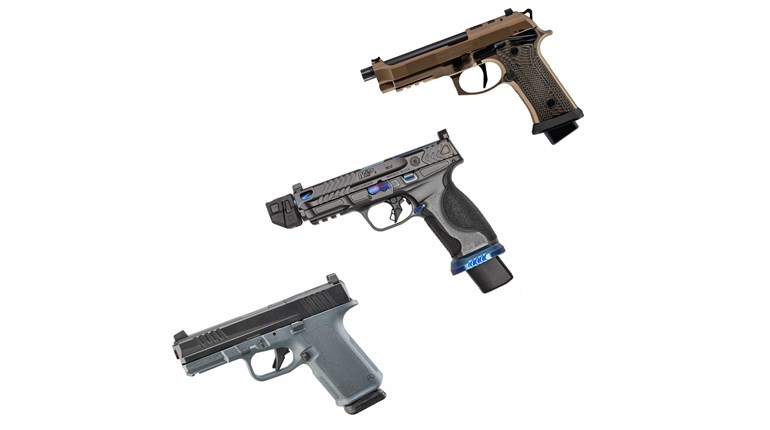
Examples of 9 mm, single-stack handguns include (from left to right): Kahr PM9; Walther CCP M2; Springfield Armory XD-S and Glock G43.
The pre-SHOT Show announcement of Glock’s new G48 pistol, a 10-shot, single-stack semi-automatic with a 4-inch barrel, triggered an incredible amount of chatter in the circles in which I run.
“What’s the big deal about a single-stack pistol?” is an understandable question.
After all, the Glock G43 and the Smith & Wesson Shield have been on the market for a little while now, as well as the Beretta Nano and Walther PPS, to say nothing of the various Kahr offerings that have been around since the 1990s.
But, see, those are all subcompacts—tiny guns, meant to compete for the same real estate on the belt, in the pocket or on the ankle that was historically occupied by five-shot J-frame revolvers and little pistols like the Walther PPK or Colt Mustang. They offered a bump in power over these traditional choices by virtue of being chambered for the more-potent 9 mm duty cartridge, but they were still little guns made harder to shoot well at speed by virtue of tiny, two-finger grips that amplified recoil.
There was a time, though, when “single-stack” was the norm across the entire spectrum of pistol sizes. Other than oddities like the Savage pocket pistols or the foreign-made Browning Hi Power, the American shooter was unlikely to run across a pistol that didn’t have its ammunition stacked one round neatly above the other in the mag.
Even in full-size service-type pistols, whether it was the M1911A1 they’d been issued in the military, the German Luger or Walther P38 Dad had brought home from fighting the Germans, or the new Model 39 that Smith & Wesson was selling, it was the 1970s before it became much of a necessity for the American handgunner to distinguish “single stack” as a separate category of pistol.
It was 1971 when Smith & Wesson combined its double-action Model 39 with a double-column magazine à la the venerable Browning High Power to create the Model 59, more or less creating an entirely new category of pistol. Described in the firearm press of the day as “wondernines,” the category was filled, over the next decade or so, with competitors from every point of the handgun-price spectrum, from Ruger’s workmanlike P85 to the elegant P7M13 from Germany’s Heckler & Koch.
Through the ’80s and into the ’90s, these double-stack, larger-capacity guns not only drove revolvers from the police market, but also eclipsed the single-stack in the eyes of the gun-buying public. They planted the flag on the mountain of market dominance when the Beretta 92 was designated the M9, the new U.S. military service sidearm in the mid-’80s, followed almost immediately by its becoming a “star” of Hollywood action flicks.
This all, however, took place before the surge in the Shall-Issue CCW movement in the U.S., which gained speed thanks to the NRA in the 1990s. During the decade of the ban years, from 1994 to 2004, the market for semi-automatic pistols—at least non-1911-pattern ones—split in two.
There were double-stack, service-size semi-autos, which were sometimes complemented by chopped-down variants ostensibly meant for concealed carry, but which shared magazine commonality with the pistols from which they were derived (e.g., Glock G17/G19, SIG Sauer P226/P228). And then there were subcompact, single-stack pistols, almost entirely aimed at the quickly swelling consumer CCW market.
It was during this era that some of the classic medium-size duty pistols went away, such as Smith’s Model 39, Beretta’s 92M and SIG Sauer's P225.
But now, just as those guns were disappearing, in the world of private-citizen-Shall-Issue CCW there was a reason for a duty-size or mid-size single-stack. Depending on attire, a slimmer pistol carried IWB that was still long enough in the grip to allow all the fingers to fit, and to have a longer barrel for more sight radius and better muzzle velocity—was something many CCW licensees found desirable, and magazine compatibility with a service pistol was not a requirement for such folks.
I heard the first rumblings of discontent even before the end of the “Assault Weapons” Ban in 2004. In the first years of the new millennium, I was a moderator at GlockTalk, the largest fan forum for Glock pistols on the internet. When Glock released the G36, a slim-line quasi-single-stack version of its double-stack .45 ACP G30, there were murmurs all over the board about how much the members wanted a single-stack version of the G19; basically, a 10-shot, 9 mm, single-stack Glock about the size of the classic Colt Commander.
It became a running joke, every time a new model number in the Glock lineup was announced: “Ooh! Maybe this is the year! Maybe this is the single-stack G19!” Startup manufacturers pitched their proposed pistols as being just like a single-stack Glock 19. SIG Sauer reintroduced the P225 single stack. The time seemed ripe for such an introduction.
And now in 2019, Glock announced the G48, which is dimensionally, for all intents and purposes, a single-stack G19. The pistol is not theoretical or hinted at, nor on the drawing board. It’s real. The reaction on the internet has been dramatic, and so that raises the question: Is this the beginning of a single-stack renaissance? Or just another one-hit wonder? Only sales numbers and the reactions of other manufacturers will tell.






































